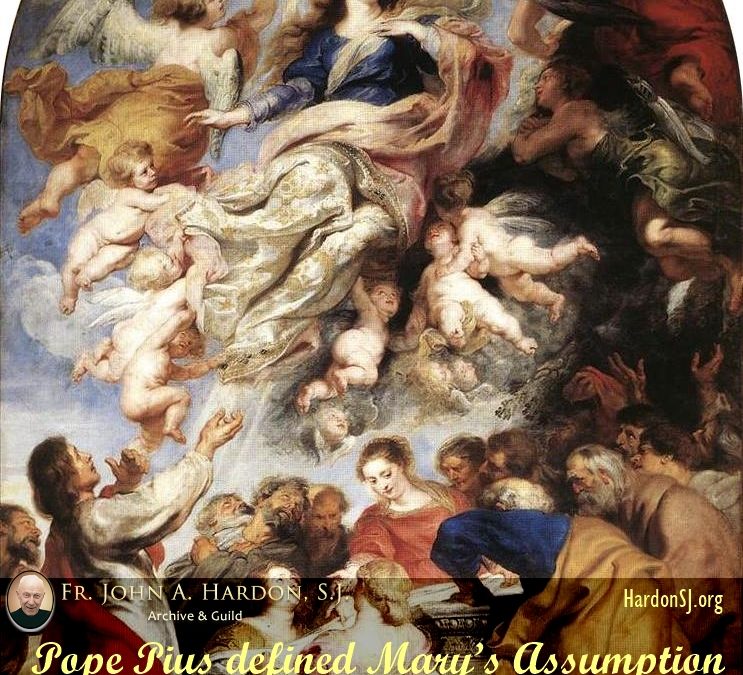by Fr. John A. Hardon, S.J.
On November 1, 1950, Pius XII answered the requests of the Catholic hierarchy with a solemn definition that, “by the authority of our Lord Jesus Christ, of the Blessed Apostles Peter and Paul, and by Our own authority, We pronounce, declare and define as a divinely revealed dogma: The Immaculate Mother of God, Mary ever Virgin, after her life on earth, was assumed body and soul to the glory of heaven.” The spontaneous reaction of the faithful was gratitude for the exalted honor paid to the Mother of God. The Pope’s own sentiments were expressed to the bishops gathered in Rome for the occasion, when he told them the joy he felt over the proclamation and the assurance it gave him that Mary would obtain the graces of which mankind stood in such dire need. On the level of piety and devotion, therefore, Mary’s Assumption was only the climax in a series of definitions to honor the Blessed Virgin, beginning with the divine maternity at Ephesus and terminating in the past century with her Immaculate Conception. But dogmatically the constitution Munificentissimus Deus has a much deeper significance that deserves to be recognized.
Shortly before the actual definition but after its public announcement, the Anglican bishops of England lodged a formal protest against the “new” dogma. “We profoundly regret,” they said, “that the Roman Catholic Church has chosen by this action to increase dogmatic differences in Christendom and has thereby gravely injured the growth of understanding between Christians based on a common possession of the fundamental truths of the Gospel.” The Anglican complaint was not a wild gesture. It exposed their radical opposition to the church’s authority over Christian doctrine, which I believe many Catholics do not fully appreciate.
Pope Pius defined Mary’s Assumption as a truth divinely revealed. Of the two sources of revelation, theologians commonly say the Assumption was implicit in tradition, in spite of the practical absence of documentary evidence before 300 A.D. Some years before the definition, a scholarly work was published under Vatican auspices on The Silence of the Early Centuries on the Assumption of the Blessed Virgin Mary. The author frankly admitted that except for apocryphal sources we have no explicit witness in the early patristic age. Yet the Pope finally declared the doctrine was in revelation. How do we know? On the answer to this question rests a new insight into Christian tradition which had been gaining momentum since the eighteenth century. Briefly stated, tradition is coming to be identified more and more with the Church’s magisterium or teaching office and less exclusively as the genetic source, along with Scripture, of the truths of salvation. Behind this new emphasis is a development of dogma since the Council of Trent which reveals hidden depths of the power in the Mystical Body of Christ. The Church is being seen more clearly as not only the guardian of a faith once and for all given to the Apostles, but as perpetual expositor of that faith in every age to the end of time.
In August of the same year that he defined the Assumption, the Pope laid down the principles which guided the Marian definition. The Church’s teaching authority, he said in Humani generis, is not confined to reflecting or consolidating the past. It is also, and especially, the vital, present-day function of an organism animated by the Spirit of God. “Together with the sources of revelation (Scripture and tradition) God has given to His Church a living magisterium to elucidate and explain what is contained in the deposit of faith only obscurely and, as it were, by implication.” The degree of obscurity, we may add, is irrelevant. Given this faculty by her Founder, whose Spirit of truth abides with her at all times, the Church can infallibly discern what belongs to revelation no matter how cryptic the contents may be.
Consequently when Pius XII defined the Assumption, he did more than propose the doctrine for acceptance by the faithful or give them a new motive for devotion to the Blessed Mother. He vindicated as never before the Church’s power to authorize a legitimate development in doctrine and piety that scandalizes those outside the true faith and may even surprise believing Catholics. The Assumption thus becomes part of a larger process, along with Catholic Action, the liturgical movement and even such practical matters as the mitigated Eucharistic fast, in which the current problems of the Church and the present needs of souls are being met by the Holy Spirit.
It was no coincidence that on the day following the Assumption definition the Pope expressed the hope that this new honor to Mary would introduce “a spirit of penance to replace the prevalent love of pleasure, and a renewal of family life, stabilized where divorce was common and made fruitful where birth control was practiced.” If there is one feature that characterizes the modern world it is the cult of the body. Science and ingenuity exhaust themselves in providing for bodily comforts, avoidance of pain, and the pampering of every sensual desire. Divorce and birth control, lurid reading and entertainment are only symptoms of a deeper malady for which revelation provides at least one certain remedy: faith in the resurrection of the body, for us on the last day as for Mary on the day of her departure from this life. Since the body is made to be immortal, it is infinitely important to provide for its eternal happiness by discipline and self-control – because the alternative is also bodily immortality, but in hell, as the price of earthly pleasure against the will of God.

